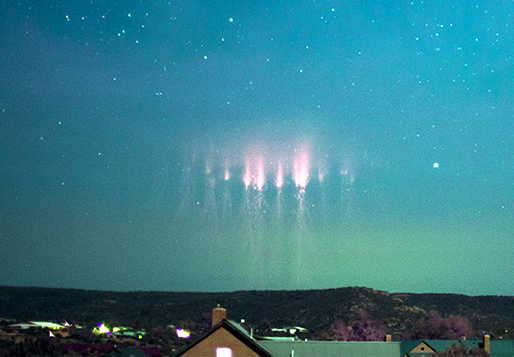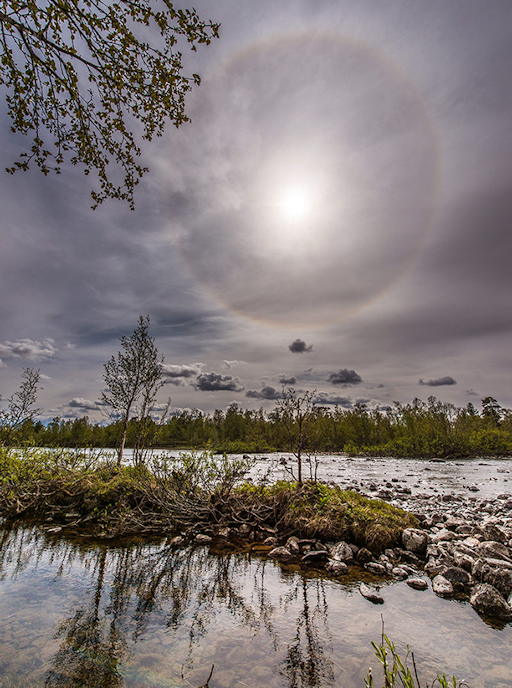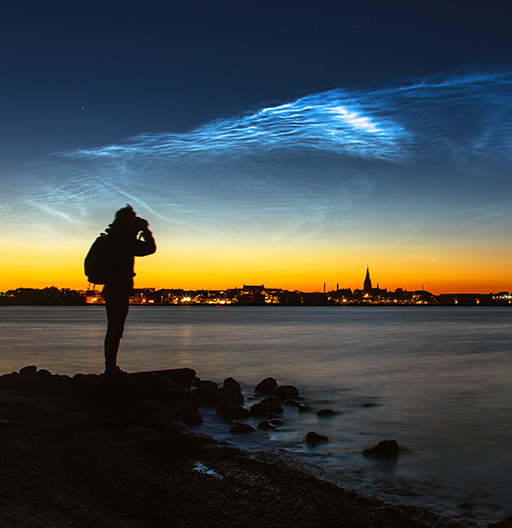It's waiting for you: The most successful Aurora Photo Tour on Earth! 100% success rate 4 years in a row and winner of the TripAdvisor Certificate of Excellence Award. Join LapplandMedia's aurora tours in Abisko, Swedish Lapland! | | | CHANCE OF MINOR STORMS: NOAA forecasters say there is a 55% chance of minor G1-class geomagnetic storms on June 16th as Earth continues to move through a region of fast-moving solar wind. High-latitude sky watchers should be alert for auroras, especially in the southern hemisphere where darkening autumn skies favor visibility of faint lights. Aurora alerts: text or voice RED SPRITES AND GREEN AIRGLOW: Thunderstorm season is underway in the northern hemisphere. That means astrophotographers should point their cameras above the clouds. Thomas Ashcraft did so on June 14th, and he captured two forms of space weather--red sprites and green airglow: 
"A large jellyfish sprite appeared over a thunderstorm in the western Oklahoma panhandle last evening," says Ashcraft. "It was about three hundred miles away from my observatory."
"I also caught it in video with very low frequency (VLF) radio emissions, and the parent lightning stroke made a strong pop," he says. Turn up the volume and play the video.
Possibly triggered by cosmic rays, sprites are a form of upper atmospheric that reach up from the tops of thunderstorms toward the edge of space. Although sprites have been seen for at least a century, most scientists did not believe they existed until after 1989 when sprites were photographed by cameras onboard the space shuttle. The "jellyfish sprite" Ashcraft captured is backlit by a band of green airglow. Airglow surrounds our entire planet, fringing the top of the atmosphere with aurora-like color. Although airglow resembles the aurora borealis, its underlying physics is different. Airglow is caused by an assortment of chemical reactions in the upper atmosphere. Auroras, on the other hand, are ignited by gusts of solar wind. Realtime Sprite Photo Gallery
ICE HALOS REFUSE TO MELT: As summer unfolds across the northern hemisphere, ice and snow are an increasingly distant memory. It's still freezing, however, in the clouds. Ice crystals floating miles above Earth's surface caused this display in Sweden: 
"This 22° halo appeared yesterday here in Kiruna," says photographer Mia Stålnacke. "It was beautiful!" Ice in the clouds can bend sunlight in many interesting ways, forming luminous rings, arcs, and pillars. Collectively these are known as "ice halos." They may be seen around the world during all four seasons--even summer--because it is always freezing miles overhead. Look for them whenever the sun is up and the blue sky is criss-crossed by icy cirrus clouds. More examples may be found in the realtime photo gallery: Realtime Space Weather Photo Gallery NOCTILUCENT OUTBURST: On June 13th, observers in more than half a dozen European countries witnessed a brilliant apparition of noctilucent clouds. Ruslan Merzlyakov sends this picture from Nykøbing Mors, Denmark: 
"Their brightness peaked from 00:50 to 1:20 and then, suddenly, they were almost gone," says Merzlyakov, who recorded a video of the display. Noctilucent clouds are a space weather phenomenon. They are seeded by meteoroids and hover 83 km above Earth's surface at the threshold of space. Summer is the season for NLCs because, ironically, that is when the upper atmosphere is cold enough for ice crystals to form around meteoroids in the mesosphere. Noctilucent clouds were first reported by Europeans in the late 1800s. In those days, you had to travel to latitudes well above 50o to see them. Now, however, NLCs are spreading. In recent years they have been sighted as far south as Colorado and Utah in the United States. Many researchers suspect this is a side-effect of climate change. Observing tips: Look west 30 to 60 minutes after sunset when the Sun has dipped 6o to 16o below the horizon (diagram). If you see blue-white tendrils spreading across the sky, you may have spotted a noctilucent cloud. Realtime Noctilucent Cloud Photo Gallery
Realtime Aurora Photo Gallery
Realtime Comet Photo Gallery Every night, a network of NASA all-sky cameras scans the skies above the United States for meteoritic fireballs. Automated software maintained by NASA's Meteoroid Environment Office calculates their orbits, velocity, penetration depth in Earth's atmosphere and many other characteristics. Daily results are presented here on Spaceweather.com. On Jun. 16, 2016, the network reported 14 fireballs.
(14 sporadics)  In this diagram of the inner solar system, all of the fireball orbits intersect at a single point--Earth. The orbits are color-coded by velocity, from slow (red) to fast (blue). [Larger image] [movies] Potentially Hazardous Asteroids ( PHAs) are space rocks larger than approximately 100m that can come closer to Earth than 0.05 AU. None of the known PHAs is on a collision course with our planet, although astronomers are finding new ones all the time. On June 16, 2016 there were potentially hazardous asteroids. Notes: LD means "Lunar Distance." 1 LD = 384,401 km, the distance between Earth and the Moon. 1 LD also equals 0.00256 AU. MAG is the visual magnitude of the asteroid on the date of closest approach. | | Cosmic Rays in the Atmosphere | | Situation Report -- Oct. 30, 2015 | Stratospheric Radiation (+37o N) | | Cosmic ray levels are elevated (+6.1% above the Space Age median). The trend is flat. Cosmic ray levels have increased +0% in the past month. | | Sept. 06: 4.14 uSv/hr (414 uRad/hr) | | Sept. 12: 4.09 uSv/hr (409 uRad/hr) | | Sept. 23: 4.12 uSv/hr (412 uRad/hr) | | Sept. 25: 4.16 uSv/hr (416 uRad/hr) | | Sept. 27: 4.13 uSv/hr (413 uRad/hr) | | Oct. 11: 4.02 uSv/hr (402 uRad/hr) | | Oct. 22: 4.11 uSv/hr (411 uRad/hr) | These measurements are based on regular space weather balloon flights: learn more. Approximately once a week, Spaceweather.com and the students of Earth to Sky Calculus fly "space weather balloons" to the stratosphere over California. These balloons are equipped with radiation sensors that detect cosmic rays, a surprisingly "down to Earth" form of space weather. Cosmic rays can seed clouds, trigger lightning, and penetrate commercial airplanes. Our measurements show that someone flying back and forth across the continental USA, just once, can absorb as much ionizing radiation as 2 to 5 dental X-rays. For example, here is the data from a flight on Oct. 22, 2015: 
Radiation levels peak at the entrance to the stratosphere in a broad region called the "Pfotzer Maximum." This peak is named after physicist George Pfotzer who discovered it using balloons and Geiger tubes in the 1930s. Radiation levels there are more than 80x sea level. Note that the bottom of the Pfotzer Maximim is near 55,000 ft. This means that some high-flying aircraft are not far from the zone of maximum radiation. Indeed, according to the Oct 22th measurements, a plane flying at 45,000 feet is exposed to 2.79 uSv/hr. At that rate, a passenger would absorb about one dental X-ray's worth of radiation in about 5 hours. The radiation sensors onboard our helium balloons detect X-rays and gamma-rays in the energy range 10 keV to 20 MeV. These energies span the range of medical X-ray machines and airport security scanners. | | The official U.S. government space weather bureau | | | The first place to look for information about sundogs, pillars, rainbows and related phenomena. | | | Researchers call it a "Hubble for the sun." SDO is the most advanced solar observatory ever. | | | 3D views of the sun from NASA's Solar and Terrestrial Relations Observatory | | | Realtime and archival images of the Sun from SOHO. | | | from the NOAA Space Environment Center | | | the underlying science of space weather |  | Tobi -- Proud Supporter of Space Education! |  | Claim your tax refund with this UK tax rebate company and get back your overpaid tax. |  | Enjoy this fabulous range of leather sofas from a leader in the UK sofa manufacturer industry.. | | 
